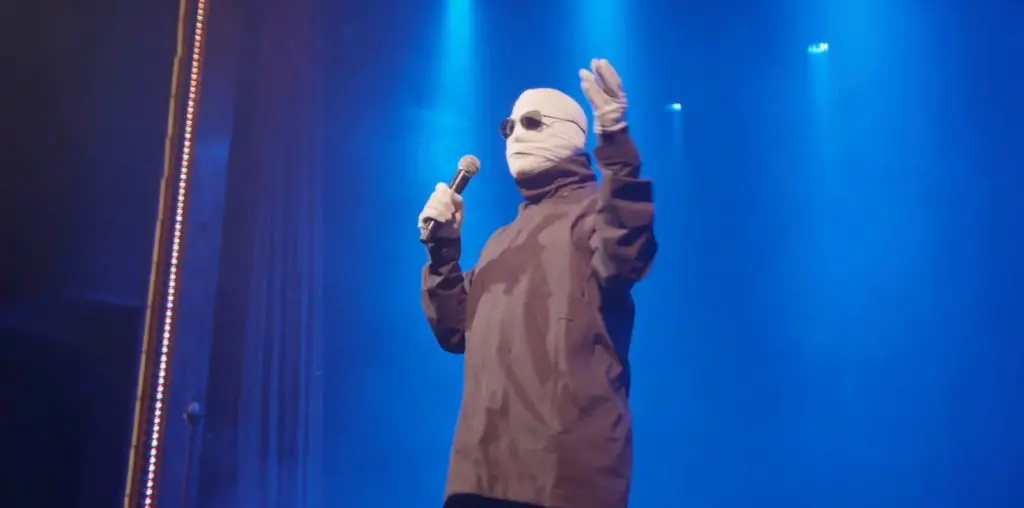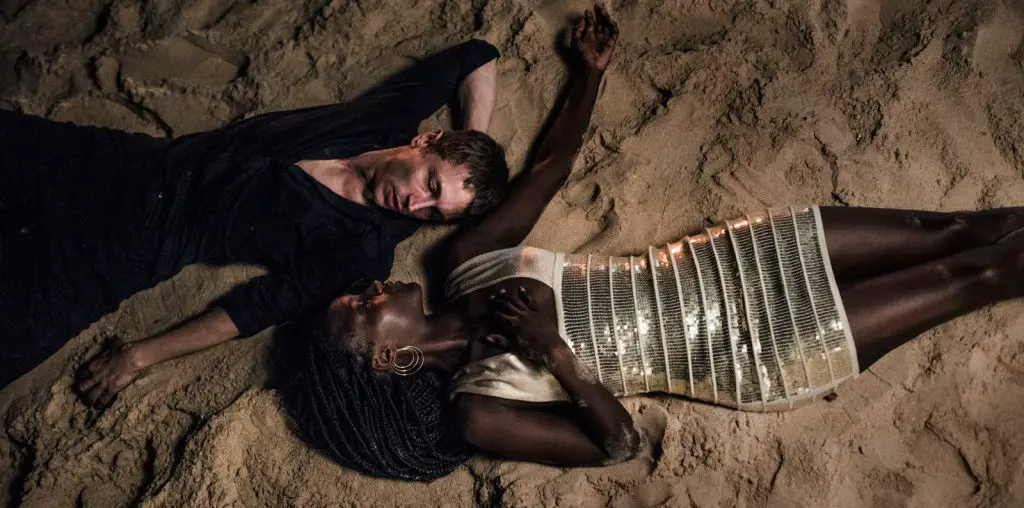
Lowave has a real winner with this delightful and important DVD collection. Every one of the ten short films included is strong, expressive, well-made, and compelling. The disk should also serve to alert people who are not yet familiar with the Collectif Jeune Cinema of Paris that this is a great place to go see experimental film. I can’t remember the last time I saw a collection of shorts, either on DVD or in a festival, in which I liked every film this much. Here are some of the highlights among the highlights:
The collection starts with a bang, with Rozen Nobilet’s film “I Motion.” The film shows the silhouette of a woman (Fayann Simpson) performing simple motions such as skipping rope and walking. Her image is subjected to multiple fragmentations and alterations. At times, we seem to be looking at several frames of film at once, as if the film had been threaded through the projector badly. The powerful sound track, by Andy Visser and Barnaby Oliver, sounds as if it could have been made by electronically altering the sound of the jump-rope, mixed with an eerie howling sound. Both the images and the sound speed up tremendously towards the end of the film, and the figure becomes more and more distorted and elongated, as if in response to the high speed. The film depicts motion in a way which resembles a cubist painting. The film is basically what you would get if you gave Eadweard Muybridge some great acid.
George Hsin and Tony Wu’s “Sentimental Journey” is a film I’ve seen at a few screenings, and I like it more every time I see it. An experimental narrative, it tells the story of a Chinese man who comes to America to explore his homosexuality. The story is narrated by the wife he leaves behind (the beautifully expressive Ten Huang). She introduces the story in three “chapters,” his departure, his journey, and his return visit. After each introductory monologue, the protagonist’s journey is expressed poetically through a collage of music, images, and loops of text. Many of the images depict American gay pride celebrations in various cities. Hsin and Wu employ the standard techniques of experimental film, such as multiple frames, colorized footage, and loops, but they are always used in an expressive, poetic, and musical way which heightens the story. Images of a pair of masculine legs, wearing stiletto heels and striding away from the camera, as well as images of a pair of feet floating in water, are repeated, creating a visual music and poetry.
“Tandem: Faux-Raccords” (images by Colas Ricard, music by Martin Gracineau) obliquely tells a story of train travel, in which a young man runs but misses a train, and a young woman, on the train, seems to fall asleep and dream. As in Hsin and Wu’s film, a full arsenal of experimental film techniques are employed (painted, scratched, even burnt film, multiple superimpositions) but to a decidedly expressive purpose. Images of the film’s optical soundtrack and sprocket holes seem to relate the experience of train travel to that of cinema. The soundtrack incorporates sounds from trains and train stations into electronic loops. The result is a satisfying, beautifully crafted film poem.
In “Geminga” (created by Hugo Verlinde), flickering lights, colored in rich red, blue, and green, are projected onto curving surfaces. It is not always obvious that these “curving surfaces” are in fact human hands. The film dances back and forth between the completely abstract space of the sparkling colored projections and the real-time, real-space world of the hands, which can only be sensed rather than clearly seen, as they catch the light. Multiple images are overlapped, creating a satisfyingly complex, intriguing texture. The soundtrack, natural sounds of flowing water and fire, reinforces the sense that we are seeing the inner electrical character of the natural world made visible. A mesmerizingly beautiful film.
In the short video “Introspection” by Richard Beaune, the voice-over text, a stream-of-consciousness celebrating the artist’s sexuality and the other pleasures of daily life, references hip-hop with it’s rhythmic re-editing of the voice and the rhythm-driven approach to writing, but without utilizing the square rhythmic structure of dance music. The images, also a personal video-journal, are similarly remixed into a hip-hoplike montage. The result is a punchy, nervy expression of a young gay man’s consciousness.
In Stéphane Marti’s outstanding film “Jardin Privé,” we see images of a beautiful garden, edited with such a frantic rhythm that the eye is rarely able to rest on a particular detail. Frequently included in the shots are explicitly pornographic images of naked, erect men, apparently in magazines strewn about the garden. It’s a natural combination: not just because of the sexual nature of flowers, but also the notion of a garden as a private space where “specimens” are artificially arranged into compositions for one’s visual pleasure. Frequent extreme close-ups of leaves and weeds, shot from ground level, imply that the garden is being enjoyed in a sensual, full-bodied way, not just by sitting politely on a bench. The constantly jump-cutting images imply a holistic mode of enjoyment, in which one is glutted with pleasure, and filled with excitement, rather than calmly contemplating individual flowers or men. The soundtrack is a mixture of birds, insects, and Rossini, which I find to be a perfect musical choice, since I think of Rossini as being a way to glut myself, somewhat guiltily, with a silly kind of pleasure. The film ends poetically, as evening falls, with more and more of the shots centered on the rising half-moon, an almost still center to the dancing images.
Experimental film/video pioneer Takahiko Iimura’s “I’m (Not) Seen” is a looped composition, in which a limited sequence of images are alternated at lightning speed. In this case, the images include the artist’s face in close-up and extreme close-up, a series of concentric black rectangular frames, the artist’s ear, and the subtitles “I am not seen” and “I see you.” The images are mostly tinted blue, with occasional brown or green. At intervals, the loop gets “stuck” on an image and displays it for as long as a half a second. Mitsuro Sato’s looped noise soundtrack compliments the imagery. The effect of this rapid sequential alternation of images is to very effectively create an altered state, one in which the viewer is simultaneously in many spaces, near and far, in the ear and in the eye. The video is a short, baffling but exhilarating trip to a very unexpected place.
In Egbert Mittelstadt’s fascinating motion study, “Unfolding,” a naked performer, July Snow, moves slowly on a black background, in sensuous movements that seem to make space tactile. Her movement is represented in two ways: by her “normal” image in the center of the screen, and in a spread-out representation in which the individual frames of her motion have been smeared together to create a long horizontal strip of color. This strip scrolls slowly across the screen, right to left, in such a way that when it passes through her body, she exactly “fits” into the shape moving over her, since that piece of the strip comes from the exact same moment of her dance. It effectively spatializes time. Her many changes of level (from high to low) as well as the occasional movement of her hand or foot away from her body create beautiful variations in the scrolled image. Somehow, by representing movement as spatial and temporal change all at once, one can admire the contour of her movement in a more intense way.

